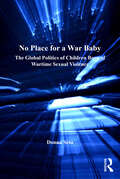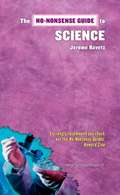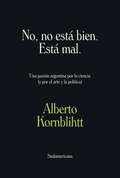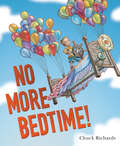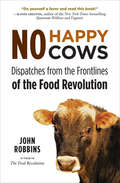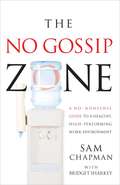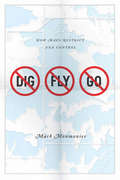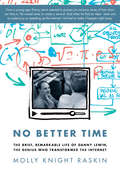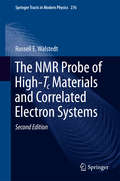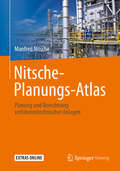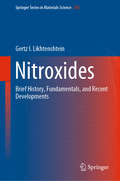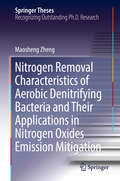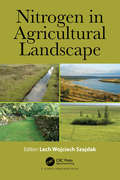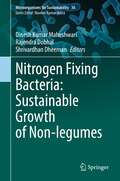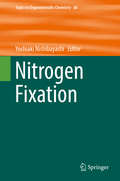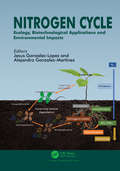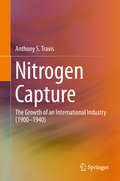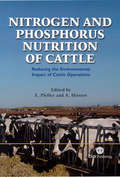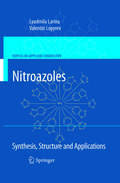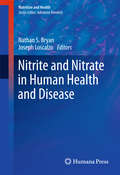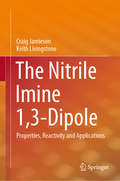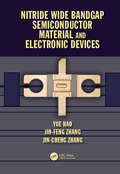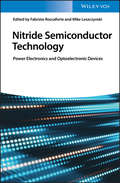- Table View
- List View
No Place for a War Baby: The Global Politics of Children born of Wartime Sexual Violence (Gender in a Global/Local World)
by Donna SetoDonna Seto investigates why children born of wartime sexual violence are rarely included in post-conflict processes of reconciliation and recovery. The focus on children born of wartime sexual violence questions the framework of understanding war and recognizes that certain individuals are often forgotten or neglected. This book considers how children are neglected sites for the reproduction of global norms. It approaches this topic through an interdisciplinary perspective that questions how silence surrounding the issue of wartime sexual violence has prevented justice for children born of war from being achieved. In considering this, Seto examines how the theories and practices of mainstream International Relations (IR) can silence the experiences of war rape survivors and children born of wartime sexual violence and explores the theoretical frameworks within IR and the institutional structures that uphold protection regimes for children and women.
No Ordinary Man: George Mercer Dawson 1849-1901
by Lois Winslow-Spragge Bradley LocknerGeorge Mercer Dawson was indeed no ordinary man. Born in 1849, son of the first Principal of McGill University, Dawson defied health circumstances that would have defeated many people and went on to become one of our most exceptional Canadians. As a geologist in the British North American Boundary Commission between Canada and the U.S.A. and as Director of the Geological Survey of Canada in 1895, Dawson examined and explored every aspect of Canada’s unknown territories. This collection of writings, letters, diaries and essays begins with the young George and moves through his developing years to his adult life. "He climbed, walked and rode on horseback over more of Canada than any other member of the Geological Survey of Canada at that time – yet to look at him, one would not think him capable of a day’s hard physical labour …. It was his hand that first traced upon vacant maps the geological formations of the Yukon and much of British Columbia."- Lois Winslow-Spragge". To read about him is like taking a drink of water from a cool, unpolluted spring. His sense of values was so great that he once said he didn’t care much for money or possessions. All he wanted was what he could hold in his canoe."- Anne Byers, Ottawa
The No-Nonsense Guide to Science
by Jerome RavetzScience is the great intellectual adventure, but can also be an instrument of profit, power, and privilege. Wrongly used, it might yet make the twenty-first century our last. To make sense of this, we need to let go of old ideas and assumptions.<P><P>This No-Nonsense Guide to Science introduces a new way of thinking about science, moving away from ideas of perfect certainty and objectivity. We must accept uncertainty and ignorance in the field, as well as the need for citizens' participation in the policies involving science.
No, no está bien. Está mal: Una pasión argentina por la ciencia (y por el arte y la política)
by Alberto KornblihttTestimonio absolutamente personal del científico argentino más reconocido en el mundo que da cuenta de su pasión por la investigación, pero también de su amor por el cine, la literatura y la música, sus obsesiones personales, su historia, su participación en la esfera pública y su reivindicación de la política. Alberto Kornblihtt le dijo "No, no está bien. Está mal" a la senadora Silvia Elías de Pérez, en el marco de las audiencias públicas previas al debate en el Congreso de la Nación de la ahora ley 27.610 de acceso a la interrupción voluntaria del embarazo. Antes de que terminara su exposición esa frase se había viralizado en las redes sociales: la oposición entre conocimiento y charlatanismo se convertía en "meme". Pero ¿quién era ese profesor universitario que con información científica y razonamiento lógico mientras expresaba su apoyo a un proyecto restituía algo de valor a la argumentación y al saber en tiempos de eslóganes y perogrulladas? Este libro absolutamente personal responde esa pregunta; presenta a uno de los científicos argentinos con más prestigio en el mundo en su faceta más humana (y, por qué no, humanista). Aquí aparecen, en primera persona, el Kornblihtt apasionado por la literatura, la música y el cine; el que se permite exponer su subjetividad y contar su historia personal y familiar; el que ejerce ciudadanía a través de sus intervenciones en la esfera pública y su reivindicación de la política y, sobre todo, el que da testimonio con su propia vida del valor social de la reflexión y el pensamiento críticos.
No More Bedtime!
by Chuck RichardsA vibrantly illustrated picture book about an inventive boy who hates bedtime, so he decides to build a top-secret machine that would put an end to it once and for all!Elliot doesn't like bedtime. It always comes before he is finished with his day! He constantly creates new inventions to outwit his parents and stay up later—like the MEGA-BOOK 5000 and the PILLOW-COPTER 5000.Nothing works, until Elliot has a brainstorm. This flash of genius leads to the ultimate machine that can keep the sun from setting for as long as Elliot wants.But is a never-ending day as amazing as it has always seemed?
No Monkeys, No Chocolate
by Melissa Stewart Allen Young<p>Everyone loves chocolate, right? But how many people actually know where chocolate comes from? How it’s made? Or that monkeys do their part to help this delicious sweet exist? <p>his delectable dessert comes from cocoa beans, which grow on cocoa trees in tropical rain forests. But those trees couldn’t survive without the help of a menagerie of rain forest critters: a pollen-sucking midge, an aphid-munching anole lizard, brain-eating coffin fly maggots—they all pitch in to help the cocoa tree survive. A secondary layer of text delves deeper into statements such as "Cocoa flowers can’t bloom without cocoa leaves . . . and maggots," explaining the interdependence of the plants and animals in the tropical rain forests. Two wise-cracking bookworms appear on every page, adding humor and further commentary, making this book accessible to readers of different ages and reading levels. <p>Back matter includes information about cocoa farming and rain forest preservation, as well as an author’s note.</p>
No Happy Cows: Dispatches from the Frontlines of the Food Revolution
by John RobbinsPioneering food activist and bestselling author John Robbins (Diet for a New America, The Food Revolution) is back with a wide-ranging collection of essays on the state of food politics today. Here John has gathered and updated his most-talked-about Huffington Post blog posts and mixed them together with some brand new writing on our food future. As ever, John's wise, clear voice cuts right through all the noise with its incisive commentary about what we should (and shouldn't) eat and why.
The No-Gossip Zone
by Sam ChapmanThe first business guide to address the leading challenge to workplace productivity and employee retention: gossip. Business leaders routinely cite gossip as one of the top problems their companies face in terms of productivity and employee retention. According to a recent study performed by Equisys, the average employee spends 65 hours a year gossiping at the office. Luckily, there is a way to turn the tide and create a positive, productive work place and it all begins with The No Gossip Zone. Sam Chapman, the owner of one of Chicago's top public relations firms, has found a way to curb the corrosive chatter and create an environment of fun, acceptance, and empowerment at work. The No Gossip program was created and honed in Chapman's firm, where employees rave about the results. From clients to coworkers, gossip is outlawed and authentic communication is encouraged and it feels great!
No Dig, No Fly, No Go: How Maps Restrict and Control
by Mark S. MonmonierSome maps help us find our way; others restrict where we go and what we do. These maps control behavior, regulating activities from flying to fishing, prohibiting students from one part of town from being schooled on the other, and banishing certain individuals and industries to the periphery. This restrictive cartography has boomed in recent decades as governments seek regulate activities as diverse as hiking, building a residence, opening a store, locating a chemical plant, or painting your house anything but regulation colors. It is this aspect of mapping--its power to prohibit--that celebrated geographer Mark Monmonier tackles in No Dig, No Fly, No Go. Rooted in ancient Egypt's need to reestablish property boundaries following the annual retreat of the Nile's floodwaters, restrictive mapping has been indispensable in settling the American West, claiming slices of Antarctica, protecting fragile ocean fisheries, and keeping sex offenders away from playgrounds. But it has also been used for opprobrium: during one of the darkest moments in American history, cartographic exclusion orders helped send thousands of Japanese Americans to remote detention camps. Tracing the power of prohibitive mapping at multiple levels--from regional to international--and multiple dimensions--from property to cyberspace--Monmonier demonstrates how much boundaries influence our experience--from homeownership and voting to taxation and airline travel. A worthy successor to his critically acclaimed How to Lie with Maps, the book is replete with all of the hallmarks of a Monmonier classic, including the wry observations and witty humor. In the end, Monmonier looks far beyond the lines on the page to observe that mapped boundaries, however persuasive their appearance, are not always as permanent and impermeable as their cartographic lines might suggest. Written for anyone who votes, owns a home, or aspires to be an informed citizen, No Dig, No Fly, No Go will change the way we look at maps forever.
No Better Time: The Brief, Remarkable Life of Danny Lewin, the Genius Who Transformed the Internet
by Molly Knight RaskinNo Better Time tells of a young, driven mathematical genius who wrote a set of algorithms that would create a faster, better Internet. It's the story of a beautiful friendship between a loud, irreverent student and his soft-spoken MIT professor, of a husband and father who spent years struggling to make ends meet only to become a billionaire almost overnight with the success of Akamai Technologies, the Internet content delivery network he cofounded with his mentor.Danny Lewin's brilliant but brief life is largely unknown because, until now, those closest to him have guarded their memories and quietly mourned their loss. For Lewin was almost certainly the first victim of 9/11, stabbed to death at age 31 while trying to overpower the terrorists who would eventually fly American Flight 11 into the World Trade Center. But ironically it was 9/11 that proved the ultimate test for Lewin's vision--while phone communication failed and web traffic surged as never before, the critical news and government sites that relied on Akamai--and the technology pioneered by Danny Lewin--remained up and running.
The NMR Probe of High-Tc Materials and Correlated Electron Systems
by Russell E. WalstedtThis new edition updates readers in three areas of NMR studies, namely, recent developments in high-Tc materials, heavy fermion systems and actinide oxides are presented. The NMR probe has yielded a vast array of data for solid state materials, corresponding to different compounds, ionic sites, and nuclear species, as well as to a wide variety of experimental conditions. The last two parts of the book are completely new in this edition, while the first part has seen major updates.This edition features the latest developments for high-Tc materials, especially the advances in the area of pseudogap studies are reviewed. An in depth overview of heavy fermion systems is presented in the second part, notably Kondo lattices, quantum critical points and unconventional superconductivity are areas of intense research recently and are covered extensively. Finally, valuable information from NMR studies with actinide oxides will be provided.Ongoing analysis and discussion of NMR data have resulted in a wealth of important insights into the physics of these exotic systems. The aims of this monograph are manyfold. First, it reviews NMR methodology as it has been applied to the different studies. This is addressed to NMR practitioners and to physics laypersons alike. Next, it presents a review of NMR measurements and the wide variety of phenomena which they represent. The third phase is to recount the theoretical model calculations and other proposals which have been put forward to account for these data.
Nitsche-Planungs-Atlas: Planung und Berechnung verfahrenstechnischer Anlagen
by Manfred NitscheDieses Fachbuch erläutert die Vorgehensweise beim Planen und Bauen einer verfahrenstechnischen Anlage. Eine verfahrenstechnische Planung besteht aus der Berechnung und Auslegung von Apparaten, Maschinen und Hilfsanlagen sowie der Organisation des Planungsablaufs. Aus diesem Grund werden in diesem Werk auch die verfahrenstechnischen Berechnungen sowie der organisatorische Ablauf in der Praxis behandelt - unter Berücksichtigung der jeweiligen Vorschriften in dem Land und ergänzt durch zahlreiche Beispiele. Ein Wärmetauscher, eine Kolonne oder ein Reaktor muss berechnet werden. Für die ausgelegten Apparate und Maschinen werden die Anfragen spezifiziert. Auch Rohrleitungen, Pumpen und Regelventile müssen ausgelegt werden. Hier ist Kreativität gefragt, Probleme müssen gelöst werden. Die Betriebsmittelversorgung muss sichergestellt sein. Auch die wirtschaftlichen Anforderungen müssen mit den physikalischen Gesetzen und den Vorschriften in den verschiedenen Ländern in Einklang gebracht werden.
Nitroxides: Brief History, Fundamentals, and Recent Developments (Springer Series in Materials Science #292)
by Gertz I. LikhtenshteinWritten by a pioneer in the development of spin labeling in biophysics, this expert book covers the fundamentals of nitroxide spin labeling through cutting-edge applications in chemistry, physics, materials science, molecular biology, and biomedicine. Nitroxides have earned their place as one of the most popular organic paramagnets due to their suitability as inhibitors of oxidative processes, as a means to polarize magnetic nuclei, and, in molecular biology, as probes and labels to understand molecular structures and dynamics AS DRAGS FOR CANCER AND OTHER DISEASES. Beginning with an overview of the basic methodology and nitroxides’ 145-year history, this book equips students with necessary background and techniques to undertake original research and industry work in this growing field.
Nitrogen Removal Characteristics of Aerobic Denitrifying Bacteria and Their Applications in Nitrogen Oxides Emission Mitigation (Springer Theses)
by Maosheng ZhengThis book systematically investigates the nitrogen removal characteristics of two screened aerobic denitrifying bacteria and their applications in nitrogen oxides emissions reduction. It reveals that Pseudomonas stutzeri PCN-1 possesses excellent capacity for aerobic nitrogen removal, regardless of whether nitrate, nitrite or N2O were taken as denitrification substrates. It also demonstrates that the rapid N2O reduction is due to the coordinate expression of denitrification genes. Further, the book discusses the bioaugmentation experiments conducted in denitrifying SBR and a pilot-scale Carrousel oxidation ditch, which confirmed that the strain could significantly enhance denitrification performance, reduce N2O emission and improve system stability. The second strain, P.aeruginosa PCN-2 accumulated negligible NO during aerobic nitrate and nitrite removal and efficiently removed NO from flue gas. This study is of great significance for potential applications of aerobic denitrification in mitigating nitrogen oxides emissions from biological nitrogen removal systems.
Nitrogen in Agricultural Landscape
by Lech Wojciech SzajdakAgriculture transforms the environment. The simplification of agroecosystems structure increases the hazards of leaching, wind and water erosion, and volatilization of chemicals from soil. Soil nitrogen is of interest as a major crop nutrient, but also as a potential environmental pollutant. Knowledge about the behavior of soil nitrogen is desirable in order to optimize plant growth and crop yield and to minimize environmental side effects. This book also gives information about the function of biogeochemical barriers in the form of shelterbelts, which efficiently decrease the concentrations of various forms of nitrogen in ground water.
Nitrogen Fixing Bacteria: Sustainable Growth of Non-legumes (Microorganisms for Sustainability #36)
by Dinesh Kumar Maheshwari Rajendra Dobhal Shrivardhan DheemanThis book covers aspects of biological nitrogen fixation along with the unique signaling and interaction between the diazotrophic bacteria and plants, especially the non-legumes. Nitrogen is the most important growth-limiting nutrient in the ecosystems and biological nitrogen fixation involving microbial symbionts, mainly rhizobia and legumes holds enormous interest across the globe. However, free-living rhizobacteria of non-legumes especially cereals, also establish themselves within the root system, fixing nitrogen and contributing to plant productivity, soil fertility, and agricultural sustainability. These non-symbiotic nitrogen fixers additionally exhibit various plant growth-promoting traits elevating productivity, fortifying nutrient content, and managing water stress in plants. The recent perspectives highlighting the mechanisms and background of non-symbiotic nitrogen fixation provide answers to unravel the potential of nitrogenase and various spectra of habitats of rhizobia and other diazotrophic bacteria. Further, the application of genetic engineering and the development of nitrogen-fixing cereals can provide a possible solution to the problem of food shortage. The book includes various scientific inputs providing comprehensive knowledge about the emergence of agricultural sustainability through nitrogen-fixing bacteria. The book illustrates the systematic mechanisms involved in biological nitrogen fixation through various illustrations, schematic drawings, and flow charts aiding in better understanding. The chapters elaborate on the physiology and metabolism of plant-bacteria interaction in different crops under diverse environmental conditions. Thus, the volume will provide a holistic scenario helping in advancing the novel plant-microbe interactions, cell-signaling, and plant-molecular interactions. The book will assist the agronomists, microbiologists, ecologists, plant pathologists, molecular biologists, environmentalists, policymakers, conservationists, and NGOs to develop biofertilizers and bioinoculants using various genera of microbes and contribute to the targets of sustainable goals in an eco-friendly manner.
Nitrogen Fixation
by Yoshiaki NishibayashiThis volume presents a review of recent developments in nitrogen fixation using transition metal-dinitrogen complexes in the last decade. The authors are international experts in the corresponding field and each chapter discusses their latest achievements in the preparation of various transition metal-dinitrogen complexes and their reactivity. This volume will be helpful to researchers, teachers, and students who are interested in innovative and sustainable chemistry.
Nitrogen Cycle: Ecology, Biotechnological Applications and Environmental Impacts
by Jesus Gonzalez-LopezAnthropogenic activity has clearly altered the N cycle contributing (among other factors) to climate change. This book aims to provide new biotechnological approach representing innovative strategies to solve specific problems related to the imbalance originating in the N cycle. Aspects such as new conceptions in agriculture, wastewater treatment, and greenhouse gas emissions are discussed in this book with a multidisciplinary vision. A team of international authors with wide experience have contributed up-to-date reviews, highlighting scientific principles and their environmental importance and integrating different biotechnological processes in environmental technology.
Nitrogen Capture: The Growth Of An International Industry (1900-1940)
by Anthony S. TravisThis monograph provides an account of how the synthetic nitrogen industry became the forerunner of the 20th-century chemical industry in Europe, the United States and Asia. Based on an earlier SpringerBrief by the same author, which focused on the period of World War I, it expands considerably on the international aspects of the development of the synthetic nitrogen industry in the decade and a half following the war, including the new technologies that rivalled the Haber-Bosch ammonia process. Travis describes the tremendous global impact of fixed nitrogen (as calcium cyanamide and ammonia), including the perceived strategic need for nitrogen (mainly for munitions), and, increasingly, its role in increasing crop yields, including in Italy under Mussolini, and in the Soviet Union under Stalin. The author also reviews the situation in Imperial Japan, including the earliest adoption of the Italian Casale ammonia process, from 1923, and the role of fixed nitrogen in the industrialization of colonial Korea from the late 1920s. Chemists, historians of science and technology, and those interested in world fertilizer production and the development of chemical industry during the first four decades of the twentieth century will find this book of considerable value.
Nitrogen and Phosphorus Nutrition of Cattle: Reducing the Environmental Impact of Cattle Operations
by Ernst Pfeffer Alexander N. HristovThis book describes the latest knowledge in nitrogen and phosphorus nutrition of cattle including requirements, ruminal and total tract metabolism, possibilities of increasing the efficiency of nitrogen utilization and reducing nitrogen and phosphorus excretions from dairy and beef operations.
Nitroazoles: Synthesis, Structure and Applications
by Lyudmila Larina Valentin LopyrevThe monograph gives an exhaustive and systematic description of the methods of synthesis, application, structure and properties of nitroazoles perspective medicines, universal bases in peptide nucleic acids, agrochemicals, and components of high-energy materials. All five-membered nitroderivatives of azoles - pyrazoles, imidazoles, triazoles, tetrazoles, oxazoles, isoxazoles, oxadiazoles, thiazoles, isothiazoles, thiadiazoles, and their benzanalogs - indazoles, benzimidazoles, benzoxazoles, benzisoxazoles, benzoxadiazoles, benzothiazoles, benzoisothiazoles, benzothiadiazoles, benzotriazoles are discussed in the book. Special attention is paid to the nitroimidazole derivatives many of which are well-known drugs and hypoxic cell radiosensitizers (azomycine, metronidazole, misonidazole, tinidazole, dimetridazole, ipronidazole, carnidazole and etc). The critical evaluation of a large body of the information on nitroazoles investigations by physicochemical methods (NMR, NQR, ESR, UV, IR- specrtoscopy, X-ray, mass-spectrometry, polarography, dipole moments and others methods) is presented here.
Nitrite and Nitrate in Human Health and Disease
by Joseph Loscalzo Nathan BryanNitrite and Nitrate in Human Health and Disease delivers a comprehensive review of nitrite and nitrate biology, from basic biochemistry to the complex physiology and metabolism of these two naturally occurring molecules in the human body. Well-organized and well referenced chapters cover the rich history of nitrite and nitrate, sources of exposure, and the physiological effects when consumed through foods containing nitrite and nitrate. The chapters are written by leading experts, all of whom share their research and perspectives in order to help define the context for benefits vs. any potential risks associated with nitrite and nitrate use, either through dietary ingestion or therapeutic dosing. This diverse collection of authors includes vascular biologists, physiologists, physicians, epidemiologists, cancer biologists, registered dieticians, chemists, and public health experts from five countries in both academia and government. Nitrite and Nitrate in Human Health and Disease provides a balanced view of nitric oxide biochemistry, and nitrite and nitrate biochemistry in physiology and in the food sciences.
The Nitrile Imine 1,3-Dipole: Properties, Reactivity and Applications (Springerbriefs In Molecular Science Ser.)
by Craig Jamieson Keith LivingstoneThis book provides a comprehensive overview of the nitrilimine 1,3-dipole, from its initial discovery in 1959 to the most recent publications. Covering topics such as the core properties of the dipole and the various methods of synthesis available, it particularly highlights the diverse reactivity profile of the nitrilimine and its numerous applications in bioorthogonal and materials chemistry. The book is of interest to academic and industrial researchers working in this area and to those new to the field.
Nitride Wide Bandgap Semiconductor Material and Electronic Devices
by Yue Hao Jin Feng Zhang Jin Cheng ZhangThis book systematically introduces physical characteristics and implementations of III-nitride wide bandgap semiconductor materials and electronic devices, with an emphasis on high-electron-mobility transistors (HEMTs). The properties of nitride semiconductors make the material very suitable for electronic devices used in microwave power amplification, high-voltage switches, and high-speed digital integrated circuits.
Nitride Semiconductor Technology: Power Electronics and Optoelectronic Devices
by Fabrizio RoccaforteGroundbreaking book that combines information on power electronics and optoelectronic applications of nitride semiconductors With contributions from a panel of international experts, Nitride Semiconductor Technology: Power Electronics and Optoelectronic Devices offers a state-of-the-art review of GaN-based technologies that covers the fields of both power electronics and optoelectronic devices. The authors present detailed explanations of the physical properties of materials and their growth methods. They also include information on GaN-based technology applications in high electron mobility transistors, vertical power devices, LEDs, laser diodes, and vertical-cavity surface-emitting lasers. Nitride Semiconductor Technology contains an in-depth examination of reliability issues with the materials and offers advice on integrating them with 2D materials for novel high-frequency and high-power devices. The book also contains a review of the most recent advances in the field. This important book: Presents an in-depth overview of properties, growth techniques, and applicability of nitride semiconductors Offers a one-stop resource that covers nitride semiconductor technology from materials to devices Reviews a widerange of nitride semiconductor applications in high-power and high-frequency devices Written for materials scientists, semiconductor physicists, semiconductor industry professionals, electrical engineers, and electrotechnical industry professionals, Nitride Semiconductor Technology: Power Electronics and Optoelectronic Devices combines the most recent information on power electronics and optoelectronic applications of nitride semiconductors.
